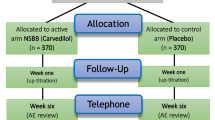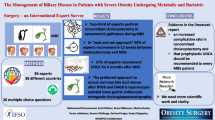Abstract
Aims and Methods
Our aim was to assess, in obese patients undergoing Roux-en-Y gastric bypass (RYGB) surgery, the cumulative Helicobacter pylori (HP) eradication rates by adopting Maastricht IV guidelines in areas of high clarithromycin resistance rates (CLT)—14 days concomitant first-line therapy with proton-pump inhibitor (PPI) bid, CLT 500 mg bid, metronidazole (MTZ) 500 bid, and amoxicillin (AMX) 1000 mg bid and 14 days second-line therapy with PPI bid, AMX 1000 mg bid and levofloxacin (LVF) 500 mg od. Single-center prospective study was over 4 years. Endoscopy and HP assessment (by histology or C13 urea breath test) were performed at baseline and post-treatment HP status was assessed by C13 urea breath test 4–6 weeks after the end of therapy.
Results
Seven hundred seventy-seven consecutive HP-positive patients completed concomitant first-line treatment: 636 (81.9%) female, age 41.1 (± 10.2) years. HP was eradicated in 556 patients—71.56% (95% CI: 68.28–74.62%). In the remaining 221 patients, second-line LVF-based regimens eradicated HP in 121 patients—54.75% (95% CI: 48.16–61.18%). These results give 87.13% (95% CI: 84.58–89.31%) ITT and 89.43% (95% CI: 87.03–91.44%) PP cumulative eradication rates. Eradication rates were not significantly different by gender, age, endoscopy findings, and smoking habits.
Conclusions
By adopting Maastricht IV consensus quadruple concomitant first-line treatment and second-line LVF-based therapy, high cumulative HP eradication rates are achieved but still leaves around 10.6% of obese patients undergoing RYGB in need of the culture and susceptibility testing prior to third-line treatment.

Similar content being viewed by others
References
Fried M, Hainer V, Basdevant A, et al. European Guidelines on surgery of severe obesity. Int J Obes. 2007;31:569–77.
Guidelines ASGE. Role of endoscopy in the bariatric patient. Gastrointest Endosc. 2008;68:1–10.
Cerqueira RM, Manso MC, Correia MR, et al. Helicobacter pylori eradication therapy in obese patients undergoing gastric by-pass surgery—fourteen days superior to seven days? Obes Surg. 2011;21(9):1377–81.
Cerqueira RM, Correia M, Fernandes CD, et al. How effective is the quadruple concomitant Helicobacter pylori eradication therapy for obese patients undergoing gastric by-pass surgery? Obes Surg. 2016;26(6):1163–6.
Mechanick JI, Youdim A, Jones DB, et al. Clinical practice guidelines for the perioperative nutritional, metabolic and nonsurgical support of the bariatric surgery patient—2013 update: cosponsored by American Association of Clinical Endocrinologists. Obes Soc Am Soc Metab Bariatric Surg Obes. 2013;21(Suppl 1):S1–27.
Scheffel O, Daskalaskis M, Weiner RA. Two important criteria for reducing the risk of postoperative ulcers at the gastrojejunostomy site after gastric bypass: patient compliance and type of gastric bypass. Obes Facts. 2011;4(Supp 1):39–41.
Eslick GD, Lim LL, Byles JE, et al. Association of Helicobacter pylori infection with gastric carcinoma: a meta-analysis. Am J Gastroenterol. 1999;94:2373–9.
Orlando G, Pilone V, Vittiello A, et al. Gastric cancer following bariatric surgery. Surg Laparosc Endosc Percutan Tech. 2014;24:400–5.
Malfertheiner P, Megraud F, O’Morain C, et al. Current concepts in the management of Helicobacter pylori infection: The Maastricht III Consensus Report. Gut. 2007;56:772–81.
Graham DY, Fischbach L. Helicobacter pylori treatment in the era of increasing antibiotic resistance. Gut. 2010;59:1143–53.
Cerqueira RM, Correia MR, Fernandes CD, et al. Cumulative Helicobacter pylori eradication therapy in obese patients undergoing gastric bypass therapy. Obes Surg. 2013;23:145–9.
Malfertheiner P, Megraud F, O’Morain CA, et al. Management of Helicobacter pylori infection—the Maastricht IV/Florence consensus report. Gut. 2012;61:646–64.
Megraud F, Coenen S, Versporten A, et al. Helicobacter pylori resistance to antibiotics in Europe and its relationship to antibiotic consumption. Gut. 2013;62:34–42.
WHO. The global burden of disease: 2004 update (online), http://www.who.int/healthinfo/global burden disease/2004 report update/en/index/html (2008)
Kearney DJ, Brousal A, et al. Treatment of Helicobacter pylori infection in clinical practice in the United States. Dig Dis Sci. 2000;45:265–71.
Saad RJ, Chey WD. Treatment of Helicobacter pylori infection in 2006. Gastroenterol Hepatol Ann Rev. 2006;1:30–5.
Mégraud F. H. pylori antibiotic resistance: prevalence, importance and advances in testing. Gut. 2004;53:1374–84.
Wu DC, Hsu PI, Wu JY, et al. Sequential and concomitant therapy with 4 drugs are equally effective for eradication of H pylori infection. Clin Gastroenterol Hepatol. 2010;8:36–41.
Molina Infante J, Pazos-Pacheco C, Vinagre-Rodriguez G, et al. Non bismuth quadruple concomitant therapy versus standard triple therapy for clarithromycin susceptible H pylori and versus quadruple sequential therapy for clarithromycin resistant H pylori. Helicobacter. 2012;17(4):269–76.
Saad RJ, Schoenfeld P, Kim HM, et al. Levofloxacin based triple therapy versus bismuth based quadruple therapy for persistent Helicobacter pylori infection: a meta-analysis. Am J Gastroenterol. 2006;101:488–96.
Gisbert P, Morena F. Systematic review and meta-analysis: levofloxacine based rescue regimens after Helicobacter pylori treatment failure. Aliment Pharmacol Ther 16:1047–1057.
Gisbert JP, Gisbert JL, Marcos S, et al. Empirical rescue therapy after Helicobacter pylori treatment failure: a 10 year single center study of 500 patients. Aliment Pharmacol Ther. 2008;27:346–54.
Rokkas T, Sechopoulos P, Robotis I, et al. Cumulative H. pylori eradication rates in clinical practice by adopting first and second line regimens proposed by the Maastricht III consensus and a third line empirical regimen. Am J Gastroenterol. 2009;104:21–5.
Acknowledgements
The author Manso MC acknowledges Fundação para a Ciência e a Tecnologia through grant UID/Multi/04546/2013 and UID/ QUI/50006/2013—POCI/01/0145/FERDER/007265.
Financial Support
None
Author information
Authors and Affiliations
Corresponding author
Ethics declarations
Guarantors of the Article
Rute Cerqueira MD
Conflict of Interest
The authors declare that they have no conflict of interest.
Rights and permissions
About this article
Cite this article
Cerqueira, R.M., Correia, M., Vilar, H. et al. Cumulative Helicobacter Pylori Eradication Rates by Adopting First- and Second- Line Regimens Proposed by the Maastricht IV Consensus in Obese Patients Undergoing Gastric Bypass Surgery. OBES SURG 28, 743–747 (2018). https://doi.org/10.1007/s11695-017-2915-z
Published:
Issue Date:
DOI: https://doi.org/10.1007/s11695-017-2915-z




